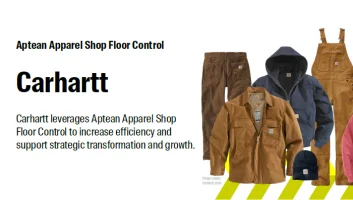6 Industry Challenges Apparel Manufacturing Software Solves
6 Industry Challenges Apparel Manufacturing Software Solves
6 Industry Challenges Apparel Manufacturing Software Solves
26 Mar 2025
Aptean Staff Writer
We’ve all seen how a single strategic choice can change the course of a story—whether it’s Frodo volunteering to take the one ring to Mordor, Luke traveling to Dagobah to train with Master Yoda, or even Kevin choosing to defend his home against the Wet Bandits. One pivotal decision can set significant change in motion.
While deciding to implement apparel manufacturing software may not have quite the gravitas of saving all of Middle Earth from the clutches of evil, it can still change the trajectory of your business journey. By leveraging advanced technology, you can tackle long-standing industry challenges and drive meaningful improvement in your apparel operations. And hey, that’s pretty heroic too, right?
Whether it’s reducing waste, improving inventory management or ensuring sustainability, the right tools can do more than streamline processes—they can redefine how you approach manufacturing altogether.
Modern solutions like enterprise resource planning (ERP) systems, product lifecycle management (PLM) software, shop floor control (SFC) and transportation management systems (TMS) empower manufacturers like you to make informed decisions, optimize resources and adapt to ever-changing demands.
In this blog, we’ll explore six common obstacles in apparel manufacturing and how the right software can help you overcome them. By the end, you’ll understand how these tools not only solve immediate problems but also lay the foundation for long-term efficiency and sustainability. In other words, they give you the tools to be the hero who reshapes the story.
Waste: The Cost of Inefficient Material Usage
As an apparel manufacturer, managing waste is a constant challenge. From fabric scraps during production to unsold inventory languishing in warehouses, inefficiencies in material management affect your bottom line. These inefficiencies don’t just hurt financially—they also tarnish your reputation as sustainability becomes a priority for consumers.
Inefficient material usage often stems from outdated planning processes, poor inventory tracking and a lack of collaboration between design and production teams. Without the right systems in place, you risk over-ordering raw materials or failing to repurpose excess inventory effectively.
The Solution: How Apparel PLM and ERP Software Cut Waste
PLM software is your secret weapon in minimizing waste right from the beginning of your new product development (NPD) process by facilitating better prototyping and resource allocation. By creating accurate digital prototypes, you can test designs virtually before committing to physical production. This reduces fabric waste from trial-and-error sampling, helping your organization move toward a more sustainable production model. Additionally, PLM software centralizes data and enables seamless tracking across a product’s full lifecycle—helping you iterate for product longevity and bolster recycling or responsible disposal efforts.
Material resource planning (MRP) functionality within specialized apparel ERP complements your PLM by managing raw materials with pinpoint accuracy to minimize waste. It taps into real-time data and historical patterns to forecast exactly what you’ll need, so you’re ordering just the right amount—no more, no less. That means no piles of excess inventory gathering dust but plenty of stock to keep production humming along. Plus, with an ERP system giving you a crystal-clear view of your supply chain, it’s easy to spot chances to repurpose surplus materials or make your procurement process even leaner.
For instance, an apparel manufacturer using both PLM and ERP can analyze historical data to optimize fabric cuts and minimize scrap. By integrating these systems, you gain a comprehensive view of your material usage and can take proactive steps to reduce waste. The result? Lower costs and a greener production process.
Waste reduction isn’t just about saving money. It’s about meeting consumer expectations for sustainable practices, too. With the right apparel manufacturing software, your organization can take meaningful steps toward sustainability while improving operational efficiency.
The Labor Bottleneck: Managing Skilled Labor and On-Floor Productivity
The apparel industry’s reliance on skilled labor creates a unique set of challenges. Finding and retaining experienced workers has become increasingly difficult, especially in an era of shifting workforce dynamics. On top of that, ensuring your current employees are as productive as possible requires continuous monitoring and optimization—a task easier said than done.
Labor shortages lead to delayed production schedules and higher costs, while inefficiencies on the shop floor can cause bottlenecks that disrupt your entire workflow. Without the proper tools, it’s nearly impossible to manage these challenges effectively. Enter apparel manufacturing software.
The Solution: How Apparel SFC Optimizes Productivity
An apparel SFC system can transform how you manage your workforce. By providing real-time visibility into production lines, shop floor control software enables you to track each worker’s output, identify bottlenecks and allocate resources where they’re needed most. This ensures that your employees—your most valuable asset—are working efficiently.
Suppose you’re struggling with inconsistent productivity across shifts on the factory floor. With an apparel SFC system in place, you can monitor performance metrics for each operator and identify areas where additional training or support might be required. This targeted approach to workforce management ensures every worker is empowered to perform at their best, ultimately boosting overall productivity and morale.
Moreover, SFC integrates seamlessly with your apparel ERP system, allowing you to connect labor data with other operational metrics. This holistic view helps you make informed decisions about staffing, scheduling and resource allocation, reducing downtime and maximizing efficiency. With SFC, you’re not just optimizing productivity—you’re creating a more engaged and empowered workforce.
Finally, SFC, PLM and ERP can all mitigate the effects of labor shortages by automating repetitive tasks and simplifying complex workflows, with the most advanced systems also offering artificial intelligence (AI) assistants to provide instant, context aware support for your employees. By augmenting your workforce with apparel manufacturing technology, you can maintain high levels of productivity even with fewer employees. After all, the key to thriving in today’s labor market is working smarter, not harder.
Inclusivity, Personalization and Slow Fashion: Are You Falling Behind?
Consumers today demand more than just availability and quality—they want personalization, inclusivity and sustainable options. The rise of slow fashion emphasizes thoughtful production, while inclusivity calls for a broader range of sizes, styles and designs. Meeting these expectations requires agility and innovation, but traditional manufacturing methods often fall short.
If your organization can’t keep up with these trends, you risk losing relevance in an increasingly competitive market. Without the best apparel manufacturing software in your corner, balancing speed, customization and sustainability feels impossible.
The Solution: How ERP and PLM Drive Fashion and Apparel Innovation
Tailored apparel PLM and ERP systems drive product innovation by streamlining collaboration, enabling data-driven decision-making for faster, more informed new product development (NPD). ERP systems equipped with electronic data interchange (EDI) capabilities and out-of-the-box vendor portals facilitate seamless data transfer between departments and external partners, accelerating decision-making and improving collaboration. With these apparel software solutions delivering enhanced agility, you can quickly respond to changes in consumer preferences, delivering on the latest trends without compromising efficiency.
Meanwhile, PLM streamlines the design process by centralizing data, improving product portfolio management and boosting collaboration across teams—this frees up time for your staff to innovate and iterate, testing out more inclusive and sustainable designs. In addition, dedicated fashion and apparel PLM systems speed up time-to-market, ensuring you can capitalize on these trends quickly—all without increasing costs or creating excess waste. This helps you meet demands for inclusivity and personalization while aligning with the principles of slow fashion.
Consider a scenario where your organization wants to introduce a new line of customizable garments. With a fashion PLM, you can test multiple design variations virtually, ensuring the final product meets consumer expectations. Meanwhile, an ERP for apparel manufacturers has effective data management capabilities to help you coordinate production and distribution for a seamless rollout and on-time, in-full delivery.
The combination of specialized ERP and PLM software empowers your organization to stay ahead of trends, offering the personalization and sustainability consumers crave while boosting operational efficiency. By embracing these tools, you’re not just keeping up with the competition—you’re setting the standard.
Supply Chain Disruptions: Breaking the Cycle of Delays
Supply chain disruptions are a fact of life in the apparel industry. From raw material shortages to shipping delays, these disruptions can wreak havoc on your production schedule and erode customer trust. Without clear visibility into your supply chain, addressing these issues feels like fighting an uphill battle.
The ripple effects of supply chain disruptions impact every aspect of your business, from material procurement to order fulfillment. To break this cycle, you need apparel manufacturing software that provides clarity and control from end to end.
The Solution: How ERP, WMS and TMS Bring Supply Chain Control
When you choose a great apparel ERP system with a built-in warehouse management system (WMS), you’ll have near end-to-end visibility into your supply chain. A TMS adds the cherry on top by providing transparency in the final mile—tracking your finished products from warehouse dispatch to your customer.
To begin, an ERP system enhances supply chain agility by monitoring your inventory, automating order tracking and helping you manage supplier relations for increased flexibility. This reduces the risk of delays and ensures that production schedules remain on track. Next, WMS capabilities accelerate receiving, optimize space management and boost picking and packing efficiency, reducing delays in getting your orders out the door and keeping fulfillment on schedule.
Finally, transportation management solutions optimize logistics and ensure timely deliveries. Multi-carrier management capabilities allow you to pivot between logistics suppliers based on costs, delivery times and service levels, giving you the control to work around bottlenecks in your logistics network. Meanwhile electronic proof of delivery tools and real-time tracking deliver immediate notification of delays allowing you to adjust to keep deliveries on track.
Together, the above solutions can help you monitor every stage of your apparel supply chain, from raw material procurement to final product delivery. This level of control empowers your teams to respond swiftly to disruptions, ensures you tightly control costs with advanced supply chain management and enables you to maintain excellent customer satisfaction.
Inventory Challenges: Balancing Overstock and Stockouts
The fashion and apparel industry demands that you maintain the right balance between overstock and stockouts—but it’s also one of the toughest challenges. Overstock ties up capital, consumes valuable warehouse space and risks obsolescence, especially when trends shift. On the other hand, stockouts can lead to missed sales opportunities, dissatisfied customers and even damaged relationships with your retail partners. The stakes are high and without precise planning, inventory management can quickly spiral out of control.
This balancing act is further complicated by the fast-paced nature of fashion seasons and unpredictable demand. Traditional methods of inventory management often rely on guesswork, leaving your business vulnerable to costly miscalculations. You need a smarter approach—one that leverages data-driven decision-making to optimize stock levels and ensure you’re prepared for any fluctuation in demand.
The Solution: Smart Decisions With ERP Inventory Management Functionality
To avoid overstock and stockouts, you need an apparel ERP system featuring an effective inventory management system. Through advanced features of apparel ERP, like forecasting and demand planning, your business can monitor inventory across multiple warehouses, analyze historical sales data and predict future demand—all from one centralized platform. This empowers you to make informed decisions that prevent overstocking while keeping shelves stocked with what customers want.
The best apparel ERP systems also excel at integrating inventory management with other critical functions like production planning and sales forecasting. When your inventory data is synced with your supply chain, your organization avoids production bottlenecks caused by raw material shortages or excesses. By automating these connections, your ERP eliminates inefficiencies and ensures smoother operations at every stage of the process.
What’s more, your workers gain access to tools like barcode scanning and lot tracking, making warehouse operations more accurate and efficient. Mistakes in order picking or shipment become a thing of the past, reducing returns and improving customer satisfaction. With better visibility and control, your inventory becomes a strategic asset, not a constant headache.
For garment manufacturing, the benefits extend further. Fashion and apparel ERP systems allow you to plan for peak demand periods, ensuring your raw materials and finished goods are ready when the season hits. This level of agility not only saves costs but also positions your business to outpace competitors who are stuck managing inventory the old-fashioned way.
Market Saturation: Balancing Costs and Competitiveness
Competition in apparel manufacturing is fiercer than ever. This means that not only do you have to offer products that satisfy consumer demands, you have to do it at price points that compete, too. And that’s while you contend with rising labor costs, fluctuating material prices and the constant pressure to deliver high-quality products at razor-thin margins. Staying cost-competitive requires more than just cutting expenses—it demands innovation in how you operate.
Efficiency is the key. Streamlining your workflows, reducing waste and optimizing resource utilization are all critical to staying ahead of the competition. But achieving this level of efficiency is no easy feat, especially with manual processes and disconnected systems slowing you down. That’s where the right apparel manufacturing technology can make all the difference.
The Solution: Apparel Software Solutions for Enhanced Operational Efficiency
Software solutions like ERP, TMS, SFC and PLM work together to optimize your apparel manufacturing operations. These tools automate workflows, streamline resource allocation and empower you to increase production with greater productivity, efficiency and cost control. Whether you're dealing with labor constraints, supply chain challenges, or rising costs, automation is the key to staying ahead in a competitive market.
ERP forms the backbone of your efficiency strategy by seamlessly integrating financial, production and supply chain data. This unified approach provides real-time visibility into potential inefficiencies, allowing you to take immediate corrective actions—like improving procurement practices or fine-tuning production schedules.
A TMS can reduce logistics costs through optimized route planning and load management. With real-time tracking and performance management, you can minimize shipping expenses while strategic capabilities allow you to model new strategies to boost efficiency further. Meanwhile, an SFC system can give you real-time visibility into production processes, allowing you to monitor worker productivity and machine utilization. For example, if a bottleneck occurs on the line, your SFC system alerts you immediately.
Finally, PLM systems bring it all together by fostering collaboration during the design and development phases. By centralizing design specs, compliance requirements and vendor communications, your business can streamline its product development cycle, getting to market quicker. What’s more, PLM ensures your garments are designed with cost efficiency in mind from the start—giving you an edge in pricing without sacrificing quality.
Why Choose Aptean for Your Apparel Manufacturing Software Needs?
Throughout this blog, we’ve explored how tools like ERP, PLM, SFC and TMS address common issues right across your operation. By leveraging these systems, your business can transform challenges into opportunities, staying agile and profitable in an ever-evolving market.
Enter Aptean. With decades of experience and deep industry expertise, we understand the unique demands of the apparel industry. Our apparel software suite is designed specifically to meet your needs, offering comprehensive solutions that integrate seamlessly into your operations. Our commitment to innovation and customer support ensures your business is always equipped to tackle the next challenge.
The full suite includes apparel ERP for end-to-end operational visibility, SFC for real-time production control, PLM for seamless product development and TMS for optimized logistics. Each system is designed to work in harmony, creating an ecosystem that streamlines your business operations and drives efficiency.
But why choose us? Because we don’t just provide software—we provide solutions. Our scalable, cloud-based platforms grow with your business, our development pipeline leverage the latest technologies such AI to delivery new feature updates, and our teams are always on hand to offer best practice advice and support—ensuring you remain agile and competitive as the market evolves. So, with Aptean, you’re never alone in your journey to success.
Contact us now to learn how our apparel software solutions can help you succeed in a competitive landscape.
Related Content


Start transforming your fashion and apparel business today
If you’re ready to take the next step, we’d love to help.






